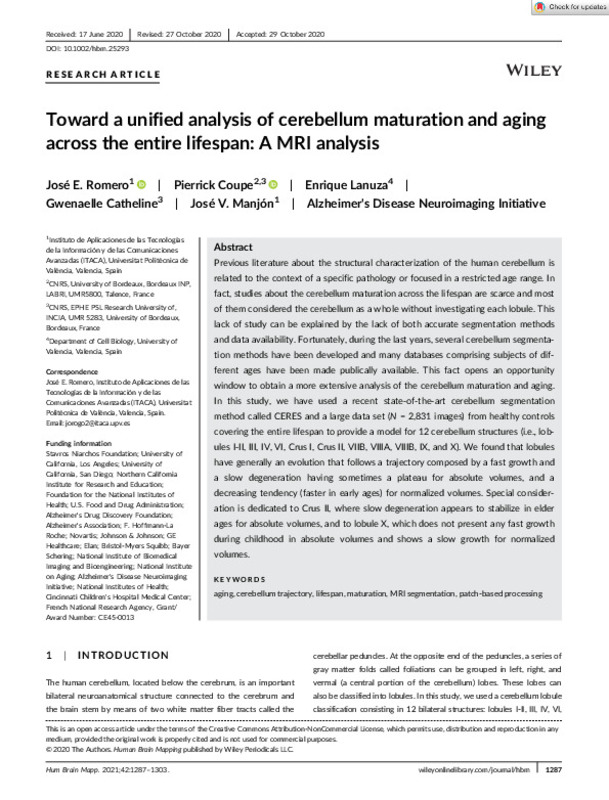JavaScript is disabled for your browser. Some features of this site may not work without it.
Buscar en RiuNet
Listar
Mi cuenta
Estadísticas
Ayuda RiuNet
Admin. UPV
Toward a unified analysis of cerebellum maturation and aging across the entire lifespan: A MRI analysis
Mostrar el registro sencillo del ítem
Ficheros en el ítem
| dc.contributor.author | Romero, José E.
|
es_ES |
| dc.contributor.author | Coupé, Pierrick
|
es_ES |
| dc.contributor.author | Lanuza, Enrique
|
es_ES |
| dc.contributor.author | Catheline, Gwenaelle
|
es_ES |
| dc.contributor.author | Manjón Herrera, José Vicente
|
es_ES |
| dc.contributor.author | Alzheimers Disease Neuroimaging Initiative
|
es_ES |
| dc.date.accessioned | 2022-06-30T18:08:13Z | |
| dc.date.available | 2022-06-30T18:08:13Z | |
| dc.date.issued | 2021-04-01 | es_ES |
| dc.identifier.issn | 1065-9471 | es_ES |
| dc.identifier.uri | http://hdl.handle.net/10251/183737 | |
| dc.description.abstract | [EN] Previous literature about the structural characterization of the human cerebellum is related to the context of a specific pathology or focused in a restricted age range. In fact, studies about the cerebellum maturation across the lifespan are scarce and most of them considered the cerebellum as a whole without investigating each lobule. This lack of study can be explained by the lack of both accurate segmentation methods and data availability. Fortunately, during the last years, several cerebellum segmenta- tion methods have been developed and many databases comprising subjects of dif- ferent ages have been made publically available. This fact opens an opportunity window to obtain a more extensive analysis of the cerebellum maturation and aging. In this study, we have used a recent state-of-the-art cerebellum segmentation method called CERES and a large data set (N = 2,831 images) from healthy controls covering the entire lifespan to provide a model for 12 cerebellum structures (i.e., lob- ules I-II, III, IV, VI, Crus I, Crus II, VIIB, VIIIA, VIIIB, IX, and X). We found that lobules have generally an evolution that follows a trajectory composed by a fast growth and a slow degeneration having sometimes a plateau for absolute volumes, and a decreasing tendency (faster in early ages) for normalized volumes. Special consider- ation is dedicated to Crus II, where slow degeneration appears to stabilize in elder ages for absolute volumes, and to lobule X, which does not present any fast growth during childhood in absolute volumes and shows a slow growth for normalized volumes. | es_ES |
| dc.description.sponsorship | Stavros Niarchos Foundation; University of California, Los Angeles; University of California, San Diego; Northern California Institute for Research and Education; Foundation for the National Institutes of Health; U.S. Food and Drug Administration; Alzheimer's Drug Discovery Foundation; Alzheimer's Association; F. Hoffmann-La Roche; Novartis; Johnson & Johnson; GE Healthcare; Elan; Bristol-Myers Squibb; Bayer Schering; National Institute of Biomedical Imaging and Bioengineering; National Institute on Aging; Alzheimer's Disease Neuroimaging Initiative; National Institutes of Health; Cincinnati Children's Hospital Medical Center; French National Research Agency, Grant/Award Number: CE45-0013 | es_ES |
| dc.language | Inglés | es_ES |
| dc.publisher | John Wiley & Sons | es_ES |
| dc.relation.ispartof | Human Brain Mapping | es_ES |
| dc.rights | Reconocimiento - No comercial (by-nc) | es_ES |
| dc.subject | Aging | es_ES |
| dc.subject | Cerebellum trajectory | es_ES |
| dc.subject | Lifespan | es_ES |
| dc.subject | Maturation | es_ES |
| dc.subject | MRI segmentation | es_ES |
| dc.subject | Patch-based processing | es_ES |
| dc.subject.classification | FISICA APLICADA | es_ES |
| dc.title | Toward a unified analysis of cerebellum maturation and aging across the entire lifespan: A MRI analysis | es_ES |
| dc.type | Artículo | es_ES |
| dc.identifier.doi | 10.1002/hbm.25293 | es_ES |
| dc.relation.projectID | info:eu-repo/grantAgreement/ANR//ANR-18-CE45-0013/ | es_ES |
| dc.rights.accessRights | Abierto | es_ES |
| dc.contributor.affiliation | Universitat Politècnica de València. Departamento de Física Aplicada - Departament de Física Aplicada | es_ES |
| dc.description.bibliographicCitation | Romero, JE.; Coupé, P.; Lanuza, E.; Catheline, G.; Manjón Herrera, JV.; Alzheimers Disease Neuroimaging Initiative (2021). Toward a unified analysis of cerebellum maturation and aging across the entire lifespan: A MRI analysis. Human Brain Mapping. 42(5):1287-1303. https://doi.org/10.1002/hbm.25293 | es_ES |
| dc.description.accrualMethod | S | es_ES |
| dc.relation.publisherversion | https://doi.org/10.1002/hbm.25293 | es_ES |
| dc.description.upvformatpinicio | 1287 | es_ES |
| dc.description.upvformatpfin | 1303 | es_ES |
| dc.type.version | info:eu-repo/semantics/publishedVersion | es_ES |
| dc.description.volume | 42 | es_ES |
| dc.description.issue | 5 | es_ES |
| dc.identifier.pmid | 33385303 | es_ES |
| dc.identifier.pmcid | PMC7927303 | es_ES |
| dc.relation.pasarela | S\462325 | es_ES |
| dc.contributor.funder | National Institute on Aging, EEUU | es_ES |
| dc.contributor.funder | National Institutes of Health, EEUU | es_ES |
| dc.contributor.funder | University of California, San Diego | es_ES |
| dc.contributor.funder | Alzheimer's Drug Discovery Foundation | es_ES |
| dc.contributor.funder | Agence Nationale de la Recherche, Francia | es_ES |
| dc.contributor.funder | National Institute of Biomedical Imaging and Bioengineering, EEUU | es_ES |








